milomom – v. to package worthless shit in boxes marked as an expensive item for the purpose of shipping out
Ex. I just milomommed all of those old crackers in that box that my hard drive came in. You should get it in three days.
milomom – v. to package worthless shit in boxes marked as an expensive item for the purpose of shipping out
Ex. I just milomommed all of those old crackers in that box that my hard drive came in. You should get it in three days.
Developer: Achebit | Publisher: Surprise Attack Games
Ever think of taking a cooperative game like Gauntlet and turning it on its head to make a competitive party game out of it? Taking fantasy classics like the warrior, cleric, wizard and… um… unicorn and putting them against the dungeon and each other? Then having them compete in various game modes that support fast and furious gameplay for the sole purpose of bragging rights? Nah… neither did I, but the guys at Surprise Attack Games and Achebit thought it would be a good idea so here I am to talk about it.
Dungeon League is a competitive party game that uses fantasy tropes to paint onto a foundation of competitive gameplay tropes to come out with a game that is shiny and new. Reminiscent of classic dungeon crawlers like Gauntlet, it takes those basic 8-bit designs and turns them into a party game where you’ll face the dungeon and each other in an assortment of competitive game modes. Add to that an assortment of varied classes, quick leveling and gameplay that supports it, you come out with basic building blocks that this game is built upon.
Still in a very early build and only about an hour’s worth of content to play through, I did enjoy the bit of multiplayer madness that the game delivered. Featuring matches that only last a couple minutes at a time, the game thrusts the players into one familiar competitive objective after the next with only a bit of downtime in between. Throwing you into a randomized assortment of objective-based gameplay like deathmatch, king of the hill, capture the flag and many more, the game seems to thrive on a fast and frantic play-style meant to push the players to complete the objectives as quickly as possible. After each round, the players are then tasked with using the bit of downtime to level up their character by way of an experience and gold system that allows them to upgrade special moves and buy items to create a beefier and stronger character for their next objective. All of this comes together into a quirky party game that could be enjoyable with friends.
The problem with friends, though, is that they have to be there to enjoy them (or they don’t exist to begin with but let’s not digress into my own personal problems) and, unfortunately, that’s not always the easiest to have around. The currently-available Tournament mode, and one of the future game types requires at least two players and with no online option to speak of, it means you’d have to gather a real life party to be able to properly enjoy half of the games types for some local play. While not too much of a major issue, it still presents a problem for those that prefer to play with friends online and for those that have no real friends (cries). On another note, while the game has some personality when dealing with the in-game vendor and trainer, that same personality seems missing in the monsters you encounter in matches. It is mostly a mix of generic monsters you’d find in most media based on a fantasy setting.
While not spectacular, Dungeon League has some potential. With a helping of two cooperative game modes and another competitive game mode on the way, the game plans to add variety to your dungeon crawling fun. Gauntlet (I see what you did there) mode provides a cooperative experience where up to 4 players will traverse a monster infested dungeon on a quest to defeat the Dungeon Master. In other cooperative fare, Survival modes pits the player and others against an endless stream of monsters all for the purpose of seeing how long they’ll last against the countless waves. Lastly, Dungeon Ball seems to be the last competitive offering to round out the game, where two teams are tasked with destroying each other, upgrading their minions and ultimately getting their ball to the end zone.
With a promise of other game types and an already fun early build, Dungeon League might warrant a look upon full release in 2016. In the end, it might just be a game worth gathering friends around.
Dungeon League is available now on Steam Early Access.
When not writing previews as Unnamedhero, Eduardo Luquin can be reached at unnamedheromk13@gmail.com.
Developer: Q-Games/Double Eleven | Publisher: Q-Games || Overall: 9.0/10
Walk the aisles of your normal, ideal, grocery store. Rows full of food line the aisles begging for your grubby little hands to take them and put them in your shopping cart. But does any food really speak to your soul as well as soup? Canned soup is one of the most important pieces of human culture, after all.
…Yet have you ever really thought about where your soup comes from?
Do you perhaps think that the planet of Alteria in the galaxy of Soupcon Valley would produce your favorite can of Green Sun Chowder made from Sunblossom and Greenstalk? Or do you think the civil war and strife of the robots on Nozesi fuel the good time tastes of the delightful Split Sea Soup and/or Filet of Fission?
PixelJunk: Nom Nom Galaxy makes you ask these questions and more. Well, actually none of that matters because the name of the game is business and market share. The real test comes in beating your enemy’s robot workers into eternal jobless poverty by creating an efficient soup factory that satisfies the needs of the universe.
Getting down to the essential basics of the game, the robots need soup and you are making the soup, delivering it to the hungry patrons via rockets. Finding material that is usable for cooking across sprawling sandboxes, you are equipped with your buzzsaw which cuts through and helps you gather many of the things you’ll need. You’ll also be punching a lot of things. On the factory production side, you’ll have to maintain, defend, and build out a soup factory that is as efficient as possible. Robot workers can be hired to assist you in this pursuit, and their operation is a small callback to the logic of Lemmings. What this ends up being is an interesting mix of game genres in a sci-fi setting with some sparse story to set up the scenarios each planet presents.
What I mostly enjoyed about Nom Nom Galaxy is that it is a sandbox game with a clear objective at hand. As far as the sandbox genre goes, Starbound is the only other game I’ve played with any large amount of time, which is built mostly on a free-form playstyle that centers on improving your crafting and character’s gear. Nom Nom Galaxy distinguishes itself from this by giving you developer-designed planets full of ingredients to exploit to the best of your ability, earning upgrades after beating a planet. The factory’s efficiency becomes a main focus of the gameplay as a result — which can be detrimental to the exploration aspect the game provides, as it essentially becomes the opposite of business efficiency.
As you make your way through the planets, each will provide an upgrade or new thing to buy to change up the gameplay a bit. Eventually you hit a point, about midway through the game, where scenarios start to take place and you’re no longer able to use defense towers, robot workers, or other things you’ve grown accustom to using. As the existing system can be a bit complex to learn and understand the controls/logic of the game, the pace is set about right. Enhancements such as, and being able to use, a double jump or a rocket boost changes the way you play entirely.
Ingredients are varied and many have specialties about them. There’s about 20 unique ingredients which can be combined with each other, resulting in 400 recipes. Some ingredients are special and take a long time to find/grow, some you have to kill mobs for, and others are common and plantable. It’s always fun to find something new in the game and seeing what will result when you combine two different ingredients can be satisfying.
When you combine ingredients, a Soup Can pops out of the Soup Machine. You take the Soup Can into the Soup Rocket, and the rocket delivers the payload which affects your market share by a base of 5%. Depending on the market trends that pop up every now and then, the game influences you to try and find different ingredients, or stop using one that might be a commonly used on in all of your Soup Machines, forcing you to change your focus.
A good 20 hours or so of gameplay got me within range of the last three stages of the “Conquest” mode. Unfortunately Nom Nom Galaxy didn’t live up to the same perfection in its difficulty as PixelJunks Monsters did, and I had a relatively easy time getting through it as I mastered the game’s logic. Half of the levels in the Conquest Mode are used to introduce you to the gameplay itself, and the latter half tests you to master it to only some unique challenge. Each planet introduced something new, but the core gameplay being so complex brings down the experience a bit, I fear. We spend too much time “learning how to play” that when we finally get around to unlocking everything substantial and playing “for realisies” you only have a couple of planets left and the last level of the game, which will require you to use everything at your disposal.
Each planet has the option for endless play, only after you attain 100% market share. You are also able to continue building your factory as it was or start from scratch in this “S.O.O.P Simulator” mode. While the planets will always be the same, they offer enough variety and quantity to not have to worry too much about that. Though since there is no meta game, you are working on each planet on an individual basis. There is also a mode called Galactic Challenges which take a unique approach to the games formula and pretty much anything seems to go here. You could be racing from point A to point B or trying to sell as much soup in 10 minutes as you can. Challenges expire after about 36 hours, and you compete against all other players here, either at the same time, or asynchronously via global rankings. You can also “Quick Join” and matchmake with another player, however the capability did not seem to be enabled in the review build before release. I assume there could be some sort of generation for planets in this mode but I can’t be sure.
A lot of the aspects of the baked-in challenge actually disincentivizes you from exploring. You’ll be dealing with maintaining the workflow of the factory, depending on its need to rely on you to acquire/scout for ingredients. You are also equipped with an Oxygen tank which limits the distance you can go without finding a source of oxygen or heading back to base. You’ll also be called back to base when your rival sends monsters to disrupt and destroy your base. You can automate the defenses a bit by loading it with laser guns and missiles, but you’ll still need to make sure you are there to pick up any of the stragglers and repair buildings. If at any point your Office is destroyed, you automatically lose the game.
At the end of each day, the game pauses for “Break Time” and saves your current progress. During Break Time you’ll be shown informative stats, graphs, and how much money you earned. An added layer of planning is involved as any ingredients that are not currently inside Soup Machines or planted will disappear. When planting items, it will expand your potential to increase your output substantially, but only if you plan correctly. Personally I felt like it made the game a lot easier to have the capability to grow your own ingredients since you could plant a lot of the same common ingredients over and over in each level and usually the AI competitor would not match very well in a challenge as long as you had a good production going. Progression to new zones is limited by recipes you discover, so there is an incentive to experiment, but not much since it was easy to meet those expectations and I never really had to replay anything unless I fucked up severely or neglected my base on purpose.
Sound and visuals is also another high point. There is a lot of insanity going on initially. It will take a while for you to understand what is going on, but the art is fantastic and intricate. The robots are uniquely designed and I loved discovering something new, or going to the next planet to see the theme. Sound is also well done for the most part, but there was a surprising lack of music. PixelJunk Monsters and PixelJunk Eden had great soundtracks, but Nom Nom Galaxy seems to take its cues from PixelJunk Shooter with a minimalist approach to music and sound, which isn’t necessarily a bad thing, just different. Monsters is probably one of my favorite soundtracks ever, so it was a bit disappointing to not have another great soundtrack to listen to.
As a big fan of the PixelJunk series I was completely satisfied with this entry. While it breaks the mold of “simplicity” all of the other games established within their own genres, Nom Nom Galaxy files down several different genres into core tenants that work together in an interesting fashion. The game is very ambitious and I enjoyed the humor quite a bit. Replayability might be Nom Nom Galaxy’s biggest fault, but there is certainly plenty to do and you can keep doing it for pretty much as long as you like. There just becomes a point where you kind of “get it” and in this case I don’t see myself coming back to visit it very often like I do with PixelJunk Monsters. It is, however, a lot easier to play the game for very long sessions.
Developer/Publisher: Cervo Media GmbH || Overall: 8.0/10
Hardware Used: iPhone 5 with iOS 6
–
Reviewing sequels to games you enjoy tend to be a typical thing when you are a reviewer. It’s easy to sit there and write out how everything in the sequel is the same, but better in so many ways, and even pull from your previous review for inspiration. In this case, Slots – Pharaoh’s Fire is the sequel to a previously reviewed title, Slots – Pharaoh’s Way; it essentially boils down to this: it is a slots game that is a sequel to a slots game and it is still… a slots game.
In my previous review I went through the ethics and personal feelings I had with the business model this slots game (now series) presents itself with. The structure is very much the same in Slots – Pharaoh’s Fire as it was in Slots – Pharaoh’s Way, and really all that you’ll initially see (if you are moving from the previous game to this) is that you are resetting back to zero. Slots – Pharaoh’s Way is an endlessly-updated grind to the next slot, and Slots – Pharaoh’s Fire is not much different. There’s no point, really, in talking about what is the same, but it’s an opportunity to talk about what IS different.
It is an interesting observation that many of the improvements I had suggested in my previous review seems to actually have come to pass — namely in more significant time-based rewards and an interesting meta game which rewards you as you play.
Free bonus credits are earned by increment of four hours as Slots – Pharaoh’s Way had done and still seem to scale higher as you progress — you also get a “special bonus” on every fourth redemption, which is a unique bonus game. The “Money Rain” bonuses (credits you earn as a bonus to leveling up) that occur also scale higher along with your level. Another vital, new, free bonus happens now in the form of a Return Bonus independent of your hourly bonus — if you visit every day your rewards slightly increase as each day goes on.
A meta game has been introduced in this title that revolves around collecting relic pieces, signified by a moving piece that represents your progress through leveling. As you complete the relics you gain a large payout of credits. Whereas before you would attain this payout at a certain increment of levels, the progression is “broken up” and given a visual representation to tell you that you are almost at the next milestone. This is a welcome change as it gives the feeling of an adventure and collecting relic pieces to add to your overall collection — of which there are many relics to collect. Your piece moves every 1/3 increment of a level and you gain a relic piece at every two levels.
Included with the meta game is also a bonus chance to earn credits within that meta game progression. A chest moves every five turns (slot plays) within your progression path, and if it appears on top of your moving piece, you get into one of the bonus games unique to this chest. One is a spinning wheel that lands on a number and the other I encountered was a “Risk to Double” game – you roll a number and risk it (to double it) by choosing heads/tails. If you lose in the Risk to Double game, you get a consolation prize regardless, but it is usually going to be a paltry amount. It is pretty much the same idea as the bonus card game that you get access to on regular slot wins. The bonus card game is still essentially useless, and the same rules apply as in the previous game. Because they are essentially the same game, I am lead to think that the Risk to Double just isn’t worth the risk.
There is more diversity in the initial few slots, and it is seemingly less reliant on the “Pharaoh’s” theme, unlike the first game. The second slot level you are all of a sudden in the African safari with elephants and shit. What happened to the God damn pyramids and whipping slaves?! I want some more Anubis and King Tut shit before I start traveling all over the world. Every 10 levels unlocks a new slot and this time around there are no numbers showing how many diamonds you earned so it’s not as easy to tell what your progress is other than a visual bar. I assume that they’ve reigned in the required amount of diamonds to make it more linear rather than it’s exponential growth that occurred in the last game, but it isn’t easy to tell.
Buying credits still seems like something predatory, but there can be plenty in-game to at least make you feel like you are earning credits with the extra bonuses and the new meta game portion. Where the ethics get involved here, is that the game has to feel rewarding to keep you hooked, but they can’t be too rewarding since they want to sell credits. It’s a very fine balancing act that appears to sometimes rig the bonus games to not be very rewarding all of the time. For example, a risk/reward game that stops between a large number and a small number will seemingly skew towards the small number more often than not. Even the “meta chest” game is privy to this, despite being essentially an added system for overall bonuses. There are lots of added bonus games involved with the title, but none are overly rewarding, which takes a little bit of the excitement out of hitting one of them.
As someone who grinded quite a few million diamonds in the previous iteration, it feels a bit daunting to get into and start yet another slots game (with essentially the same progression system) from scratch. Personally, it feels like there should either have been some sort of credit sharing between the two games, or Slots – Pharaoh’s Way upgraded with the additions they made for Slots – Pharaoh’s Fire. Business-wise, I completely understand why you would want your players to experience a full reset — the grind is necessarily subject to becoming hooked as you gain levels with more regularity at the lower levels and hitting level 243 might not mean anything anymore.
There are some graphical enhancements (addition of more 3D graphics/animations is the biggest difference) and some sound “additions” that are a bit corny as some deep-voiced European-sounding dude (read: not Egyptian) is one(?) of the performers. As always, I turned my sound off within ten minutes of booting up the game, so it didn’t matter to me.
Is the game good? Sure. It’s not any better or worse than the previous game, really. A lot of the additions I proposed were actually included and its made the game a better package, however the intent of the game is to make money at the end of the day and they can’t go too crazy with the fun. For the benefit of the series, it would be interesting to see a different progression system than grinding diamonds and levels to unlock more slots. For a more in-depth look at all of the basic functions of the game, please check out my previous review as almost all of it is relevant for this game.
retrosublimislushificatio
The process can only be initiated when a static sign stating “slushy will be ready in 20 minutes” is on an empty slushy machine. If it has not yet happened, the sign will still read 20 minutes, so you should come back in 20 minutes and check again. Repeat until it happens, otherwise it doesn’t happen.
Developer: Lancarse | Publisher: ATLUS || Overall: 8.5
Telepathy, telekinesis and psychometry are pretty legit. Pryokinesis, cyrokinesis and healing are stretching things a bit but are acceptable. Though, I absolutely refuse to believe that super-strength and teleportation are proper manifestations of psychic force. Super-strength is the supernatural ability to exceed the physical limits of natural strength and thus is regulated to the body and not the mind where psychic abilities dwell. Teleportation is the ability to instantaneously move from place to place without any of the travel in between and is centered on spatial manipulation rather than the power of the mind. Psychic sympathizers would have you believe that just because they could involve a conscious effort that they must be placed under the oppressive umbrella of a psychic power. Nay! Rise up against these ability oppressors and embrace superpower diversity!
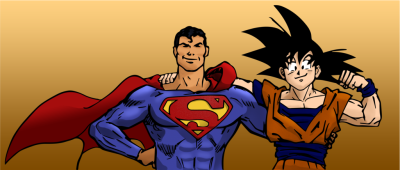
“Behold! The world’s greatest psychics!” – Ability Oppressors
Well, that’s enough of that…
Developed by Lancarse, and published by ATLUS, Lost Dimension is a Strategy Role-Playing game (SRPG) that borrows various ideas to give you a game about a group of psychics climbing an enigmatic tower. Shades of video games like Dangan Ronpa, Valkyria Chronicles and Persona, as well as other media like A Certain Magical Index (To Aru Majutsu no Index), Tokyo ESP, Arkham Horror and more are used to make the psychic SRPG soup that is this game. Though, what really sets Lost Dimension apart is a traitor mechanic that has you offing a member of your party at each floor. It all combines to make quite the familiar product with a diversifying gimmick that captures the attention.
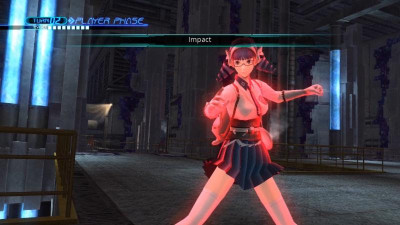
Also includes elements that will interest the school girl
fetishist out there…
At first glance Lost Dimension looks like a rather by the numbers SRPG. A simple romp where you’ll move characters across a map and eventually level your way to the top of the tower, but with the borrowing Lost Dimension does from other games it proves to play better than it looks. Much like Valkryia Chronicles, the movement is freeform instead of grid based. This usually translates to the characters having a full circle of movement and is especially useful when characters have movement abilities, like teleportation, that lets them completely bypass some obstacles on the map. Borrowing an aspect from Fire Emblem, the game’s Assist attacks reward good positioning by giving inactive units a chance to do a follow-up attack if they are close by. While this all usually plays out rather fluidly, the occasional mid-attack load screen does disrupt the flow. Though despite the minor inconvenience, both of these aspects give the game charm where there otherwise wouldn’t be any.
The story won’t get any awards but fits as an acceptable excuse for the game to play out. Thrown right into the story with very little frame of reference, you find yourself as confused as Sho who just so happens to have amnesia like the rest of his group (and every other protagonist from a JRPG). The group tasked with 13 days to climb a mysterious tower and stop a dangerous terrorist from ending the world, the most aptly named final boss in video game history, The End, thrust them into a malicious game where their trust will be tested and their allies will be killed by their own hands.
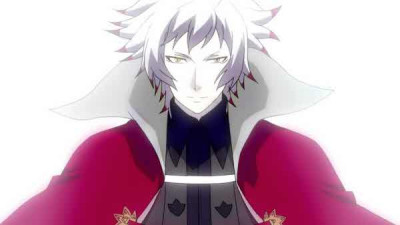
He also forces them to wear skinny jeans and listen to the
bad poetry he wrote.
The characters, on the other hand, help to make the story stand out a bit more. In a Persona-like fashion, Sho can speak to his teammates between missions to build bonds of trust with them. Small conversations eventually lead to more meaningful talks as Sho’s teammates reveal their history, concerns and even their motivations. This not only fleshes out the character, but can give you different and more impactful dialogue during certain scenes. Also, the character designs deserve some note, they’re all reminiscent of a style found in 90’s anime as opposed to a more modern approach, which some might say is “Da bomb!”
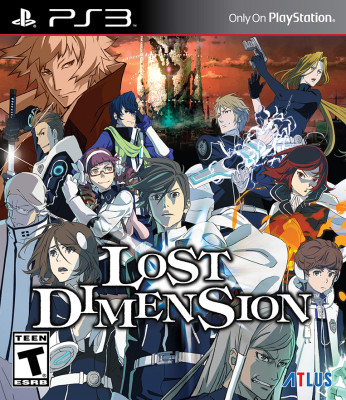
The only way for this to be more 90’s is if this was brought to you by the
same company that brought you LA Gears.
In terms of strategy, it never really evolves past taking advantage of the Assist attacks mechanic to add on extra damage. On the other hand, I did find that the difficulty increased at a fair and steady rate. In particular, the Berserk mechanic grew increasingly difficult to control and proved to be quite the double-edged sword. Much like in Arkham Horror, each character is outfitted with a Sanity meter that decreases with every special move and attack they receive, and unlike it, once depleted causes the character to go Berserk and out of control. Now other than the obvious detriment of having a character go out of control and attack both ally and foe alike, the mechanic can also turn the character into quite the heavy hitter. Time and again, I’d send a character far and away from his allies and deep into enemy territory to purposefully deplete their sanity and then immediately hit with another attack for about 2x or 3x the usual rate. Of course, if I didn’t position them wisely, my characters would be given the same treatment. Though, it was a shame that you couldn’t use the mechanic to figure out the traitor.
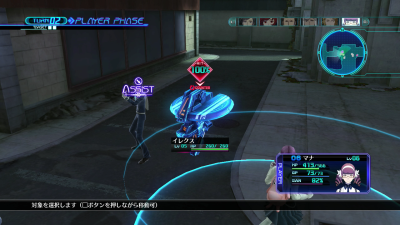
See those bright blue letters over the character’s face?
They mean you’re playing the game right.
Every floor up the tower, Lost Dimension tasks you with voting for who the traitor is among your ranks and “erasing” them from the party. If the traitor is found, they’ll be eliminated. If not, an innocent teammate will be killed instead and the traitor will then betray you some time later. Usually there are three suspects every floor with a single traitor between them that you will fish out by way of an after-battle cutscene where the main character, Sho, will read the thoughts of his teammates. Then through a mixture of careful positioning and a Vision Point system that allows Sho to dive into the minds of his teammates to discover their true intention, the traitor can be exposed. Once armed with that knowledge, Sho is able to sway his teammates by way of simple dialogue choices at the end of every encounter. Overall, being the games defining gimmick, I didn’t find it exactly inspired but still enjoyable. It gave the game an almost Dangan Ronpa-esque feel to it whenever it came time for a judgment.
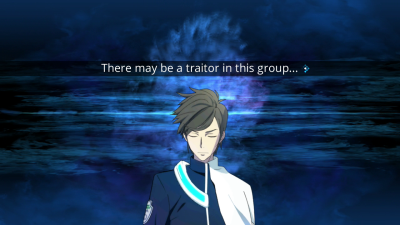
…or all of you could be innocent, regardless prepare to
have your privacy invaded!
Though an interesting gimmick, the fact that the traitor is chosen at random (except on the first floor during the first playthrough) still means the party will lose a playable character at random. This can be a bit disheartening, considering that every character plays completely different from the other. Still, Lost Dimension does it’s damndest to soften the blow. Even if a character isn’t used in battle, they get about 80% of the battle exp and, when erased, leave behind an equippable item containing their abilities for someone else to enjoy. The equipment also proves useful in unlocking combination abilities that tend to be quite powerful. Still, random is unpredictable, so your favorite character might get “erased” or you might end up with a rather sexist play-through like I did, where the game killed off all of the women to turn it from an ensemble piece to what I pretended was a buddy cop film with way less cops and way more buddies.
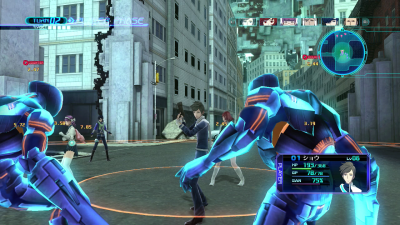
“I’m taking away your badge, Sho!’
“I didn’t want to be a psychic cop anyways!”
With the Playstation 3 now at the end of its lifespan, I found the graphics in Lost Dimension acceptable for a budget RPG. My only real complaint is that the “budget” part of the game showed during a few of the special attacks, some of them having rather big build-ups only to finish lackluster. The music was a slight step above the graphics with mysterious melodies that complemented the environment and narrative. Overall it is a pretty standard job on both fronts. The same could be said for the Vita version that has an expected reduction in graphical quality and frame rate.
Speaking of the Vita, I found the battles in the game to be much shorter than is usual for the genre. Unlike battle-heavy games like Fire Emblem and Project X Zone, the encounters only last for about 15 to 30 minutes, making it perfect for gaming on the go. Adding to that, Lost Dimension is also compatible with PlayStation TV which should make all five of you that bought both systems rather happy.
Lost Dimension was enjoyable, even if it was marred by the mid-attack load times and attacks that seemed to reflect the game’s budget price. Overall, it’s a mixture of several fun elements that make it a fun game. The borrowing it does from games like Dangan Ronpa, Valkyria Chronicles and Persona as well as other media like A Certain Magical Index (To Aru Majutsu no Index), Tokyo ESP and Arkham Horror elevate the game up to a higher bar than one may initially expect. And if you understood all of those references, you should definitely give me your number ‘cause I think we should marry.
When not writing reviews as Unnamedhero, Eduardo Luquin can be reached at unnamedheromk13@gmail.com.
–
A reviewable copy of Lost Dimension was provided to Squackle.
Your momma is so fat her belly button gets home 15 minutes before she does.
isescreschaae – v. to completely replace all of the road signs in America to change it from miles to kilometers
Ex. Porlogeneralpierdes don’t think about how stupid it would be to isescreschaae.
Podcast: Play in new window | Download
Subscribe: Apple Podcasts | RSS
Wow! I don’t know who keeps making these Squacklecasts, but they keep getting made.
–
We talk about ABC Family’s Harry Potter marathon a bit and which ones we like overall. Also we realize how we can’t remember what happens in which one or what they’re called.
Comic Con 2015 began and ended in a boring whimper considering Marvel was a no-show. Trailers from the convention are at Wired.
The current status of Marvel and how Ant-Man is or is not their current “peak.” Avengers 2 was basically Cameo: The Movie. The X-Men properties are discussed.
We talk about the DC properties which were arguably the most interesting part of this year’s Comic Con.
Movies about movies that didn’t get made — Superman Lives and pre-Lynch Dune.
Will Smith is Deadshot in the new Suicide Squad movie. Hopefully he’s more like Capt. James West from Wild Wild West:
Dave was mostly into the Garfield/Calvin and Hobbes types of comics instead of the Marvel/DC stuff.
Since Garfield likes lasagna, that was a segue into talking about food and Grilled Cheese. Billy doesn’t like Grilled Cheese because his only experience with it was eating it at a buffet.
Perfect Grilled Cheese on sourdough is as follows:
Awful wheat grilled cheese is this awful awful thing:
More random food talk about bacon and other things.
–
Davepoobond’s Hate List for Celebrities (5 is average rating)
FRED 10/10, Bono 10/10, Owen Wilson 9/10, Jackie Chan 6/10
Melissa McCarthy 10/10, Julia Roberts 9/10, Drew Barrymore 8/10, Geena Davis 7/10, Cher 4/10
–
Fuck you FRED. See you guys next time!
dintumar – n. an ugly, cracked, embarrassingly dirty driveway
coresuevutt – n. an ugly, cracked, embarrassingly dirty face
puestoari – n. an ugly, cracked, embarrassingly dirty penis
porlogeneralpierde – n. an idiot who likes to complain about how the United States doesn’t use the SI system of measurements instead of Imperial units. Shut the fuck up already, no one cares!
blarx – n. a roll of register tape that starts curving its receipts sooner than a usual roll of register tape
Note: This person’s user name was “IThriveForBlood”
–
“No, I do NOT thrive for blood. I don’t know why this is my username. I did not create it or choose it. I logged in one day and there it was. So don’t ask me if I am a vampire or any stupid crap like that. I wont answer you and will ignore you, because it will show that you did not read my profile.”
– from a girl’s dating profile